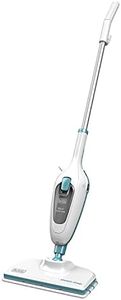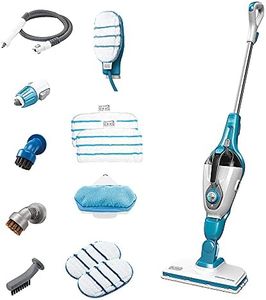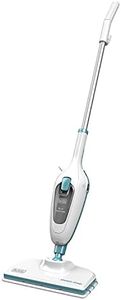We Use CookiesWe use cookies to enhance the security, performance,
functionality and for analytical and promotional activities. By continuing to browse this site you
are agreeing to our privacy policy
10 Best Floor Steamer Mop
From leading brands and best sellers available on the web.Buying Guide for the Best Floor Steamer Mop
Choosing the right floor steamer mop can transform your cleaning routine, making it quicker and more hygienic. It's important to look beyond just the shape or price—understanding the key features and how they match your needs ensures you get an effective, easy-to-use mop that works on your floors and fits your lifestyle.Water Tank CapacityThe water tank capacity tells you how much water the steamer can hold at once, directly affecting how long you can clean before refilling. Smaller tanks (under 350ml) are lighter and heat up faster, which is good for quick, small jobs or lightweight cleaning. Medium tanks (350ml–500ml) balance cleaning time and maneuverability, suitable for most households. Larger tanks (over 500ml) allow longer cleaning sessions, ideal for bigger homes or those who want to do multiple rooms in one go, but can make the mop heavier. Choose a capacity that matches the amount of floor space you typically clean in one session.
Heat-up TimeHeat-up time is how long the mop takes to be ready to produce steam after turning it on. Shorter heat-up times (10–20 seconds) are great for quick cleaning and convenience, while longer times (30 seconds–1 minute) are less ideal if you expect to clean often and need speed. Consider how much patience you have for waiting and how often you plan to use your steamer; if you’re frequently cleaning messes on the spot, a fast heat-up feature will make your life easier.
Steam Output ControlSteam output control means you can adjust how much steam the mop emits. Some models have simple on/off steam, while others allow for low, medium, or high settings. Lower steam is gentler for sensitive surfaces like sealed hardwood, while higher steam is good for tough stains or tiles. If you have a mix of floor types, adjustable control is useful to avoid damaging delicate flooring and to handle different kinds of dirt efficiently.
Mop Head DesignMop head design affects reach and effectiveness. Rectangular mop heads cover large straightforward areas quickly, whereas triangular or swivel heads are better for corners, edges, and tight spaces. Flat heads glide easily under furniture, and pivoting designs improve maneuverability. Think about the typical layout of your space—if you have lots of furniture or awkward spots, look for heads that pivot or come to a point.
Cord LengthCord length determines how far you can move without having to switch power outlets. Short cords (under 18 feet) might be fine for small rooms, but longer cords (20 feet or more) make it easier to clean multiple rooms or larger spaces with fewer interruptions. If you don’t like unplugging and moving around, opt for a longer cord that matches your room sizes.
Pad Material and ReusabilityFloor steamers use pads to trap dirt and deliver steam. These pads can be microfiber or other absorbent materials. Microfiber is durable and machine washable, making it cost-effective and eco-friendly, while disposable pads offer convenience but create waste. Consider whether you want reusable pads for long-term savings or disposables for rapid cleanup with less maintenance.
WeightWeight affects how easy the steamer is to handle, especially for extended cleaning. Lighter models (under 5 pounds) are easier to move and great for anyone who struggles with heavy lifting, while heavier models (over 7 pounds) may offer sturdiness but can become tiring during use. If you need to carry the mop upstairs or have tasks that require a lot of movement, a lighter model will be more comfortable.
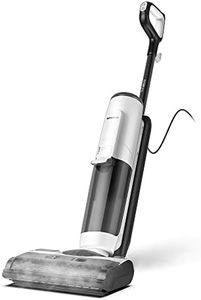

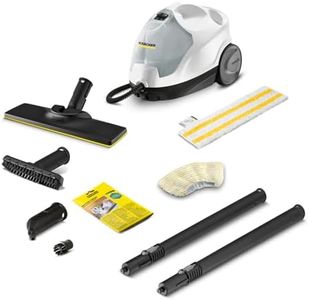
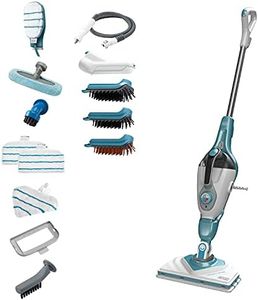


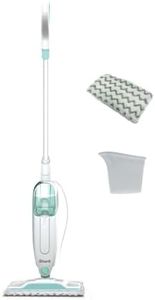
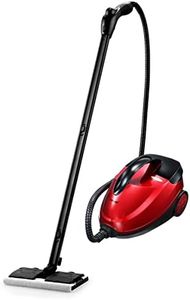
![BLACK+DECKER - Steam Mop with Hand Cleaner and 5 Accessories - Multifunctional 1300W - Heating Time 25 sec - 180° Swivel Head - 350 ml Tank - FSMH13E5-QS [Energy Class A+]](https://images-proxy.bestreviews.guide/JiWinHWIWAxzNQN8HUe2EUC_2cg=/0x300/https://m.media-amazon.com/images/I/31xBNxIp4sL._AC_CX679_.jpg)

